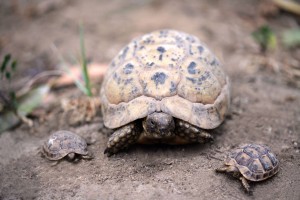Customs officers have just seized a total of 1,700 Kleinmann’s tortoises (Testudo kleinmanni) in a minibus and a heavy truck. These were the first 2 seizures observed in Libya since the July 2013 publication of “On the trail” n°1, the bulletin of Robin des Bois dedicated to poaching and smuggling endangered animal species.
They prove that despite the political and social chaos, wildlife is not completely left to the devices of traffickers and militia. The 2 vehicles were heading to Egypt. The first reports show that the 200 tortoises in the minibus were collected in the desert to the south of Tripoli. The 1,500 tortoises found in 18 bags inside the truck were collected in an area south of Benghazi.
 Testudo kleinmanni, CITES* Appendix I © Bibliotheca Alexandrina
Testudo kleinmanni, CITES* Appendix I © Bibliotheca Alexandrina
Kleinmann’s tortoise is one of the most endangered tortoises. Not long ago, its distribution range included Libya and Egypt. Except for a few isolated individuals, these tortoises have disappeared from Egypt. Its last known habitats were the coastal deserts of Tripolitania, in the western part of the country, and Cyrenaica, in the eastern part. Kleinmann’s tortoises need the moisture that the Mediterranean Sea brings. In the scorching heat of the day, and on cold nights, the tortoises bury themselves in the burrows that small mammals have abandoned. Kleinmann’s tortoises are vegetarian, but if necessary, they eat insects and the excrement of desert rodents. A female Kleinmann’s tortoise lays 5 eggs, with an incubation period of 20 days. Kleinmann’s tortoises have camouflage that is almost military. Unfortunately, this is not enough to spare it from the international pet market. A specimen sells for between $ 700 US and $ 1000 US.
See also
“On the Trail” n°11 (pdf 100 p. – 6.8 Mo)
* Convention on International Trade in Endangered Species of Wild Fauna and Flora
 Imprimer cet article
Imprimer cet article









